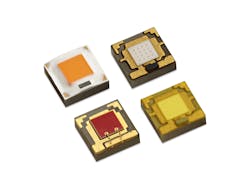Lumileds boosts performance in the Luxeon C and CZ color LED portfolios
Lumileds has long been near the top of the color LED market both in terms of performance and market share and now the company has released upgrades to its two most powerful product families, the Luxeon C and CZ. Topping the upgrades are the PC Amber devices that have increased flux by 17%, and Lumileds said that LED is critical in improving safety for emergency vehicle operations. And performance increases across the board will enable better color-tunable solid-state lighting (SSL) products and more dramatic color mixing in projection applications for façade lighting.
While color high-brightness LEDs serve a smaller overall market relative to phosphor-converted white LEDs, there are very important applications for color LEDs starting with emergency vehicles. We covered such applications and approaches to color LED architecture in a comprehensive feature article several years back. And since that article appeared, there has been tremendous growth in systems that use color tuning or mixing technologies. The Luxeon C and CZ families support such applications with Mint, Lime, Green, Cyan, Blue, Royal Blue, Violet, Far Red, Deep Red, Red, Red-Orange, Amber, and PC Amber components.
“The Luxeon color lines are known for having the greatest color selection and now they provide even higher luminous output so fixtures will require fewer LEDs to achieve their target brightness in a smaller overall footprint,” said LP Liew, product marketing manager at Lumileds.
The families include mostly monochromatic LEDs although Lumileds has used a phosphor-converted approach in some colors to deliver better efficiency or efficacy (higher radiometric power relative to input power or more lumens relative to input power). The company specifies flux output as radiometric watts for some LEDs such as in the blue range because the human visual sensitivity drops significantly for blue wavelengths. In the case of the upgraded C and CZ families, the royal blue LEDs offers a 4% upgrade in radiometric watts that is critical both in entertainment (projection) and architectural façade lighting.
The phosphor-converted LEDs include the PC Amber, Lime, and Mint LEDs. The PC Amber gets the explicit PC designation in the color name because Lumileds also offers a monochromatic Amber device. You may wonder why a developer might chose to use a monochromatic Amber with less flux output than PC Amber. There could be several reasons — for example, some applications might benefit from the relatively narrower emission band of a monochromatic LED. Lumileds also offers phosphor-converted white LEDs in both the C and CZ families for applications such as RGB+W (red, green, blue, plus white) tunable systems.
The C and CZ lines share a 2×2-mm footprint that enables close packing of color arrays and in fact the two lines uses the same manufactured LED chips. The Luxeon C family was originally launched in 2015. In addition to broad color selection and high flux output, Lumileds touted the matched Z-height of the components in the family. The monochromatic LEDs use varying material science in epitaxy and the phosphor-converted colored and white LEDs rely on different packaging steps, but Lumileds’ engineers ensure consistent height and therefore focal length so that color arrays produce true mixes with no phantom or ghosting effects.
Where the original Luxeon C LEDs had a domed primary optic, Lumileds announced the CZ family in 2018 with a minimal primary optic. The near-flat light-emitting surface (LES) of the CZ components provides a narrower beam with more center-beam punch. Still, the components maintain the consistent focal length for optimal mixing.
In addition to the high-power C and CZ components, Lumileds has also made numerous announcements of mid-power color LEDs. For example, just this past summer the company rolled out higher-performance Luxeon 2835 components. And in August the company revealed the tiny 1.4×1.4-mm Rubix family that are high-power devices.
For up-to-the-minute LED and SSL updates, why not follow us on Twitter? You’ll find curated content and commentary, as well as information on industry events, webcasts, and surveys on our LinkedIn Company Page and our Facebook page.

Maury Wright | Editor in Chief
Maury Wright is an electronics engineer turned technology journalist, who has focused specifically on the LED & Lighting industry for the past decade. Wright first wrote for LEDs Magazine as a contractor in 2010, and took over as Editor-in-Chief in 2012. He has broad experience in technology areas ranging from microprocessors to digital media to wireless networks that he gained over 30 years in the trade press. Wright has experience running global editorial operations, such as during his tenure as worldwide editorial director of EDN Magazine, and has been instrumental in launching publication websites going back to the earliest days of the Internet. Wright has won numerous industry awards, including multiple ASBPE national awards for B2B journalism excellence, and has received finalist recognition for LEDs Magazine in the FOLIO Eddie Awards. He received a BS in electrical engineering from Auburn University.





